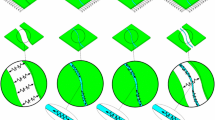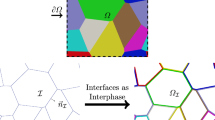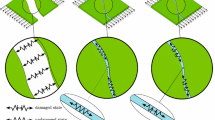Abstract
A new quasi-static and energy based formulation of an interface damage model which includes Coulomb friction at the interface between anisotropic solids is provided. The interface traction-relative displacement response is based on an assumption of a thin adhesive layer whose behaviour is analogous to cohesive zone models. The damaged interface is considered, if exposed to a pressure, as a contact zone where Coulomb friction law is also taken into account. As the contacting solids are generally anisotropic, the friction may exhibit some anisotropic behaviour, too, which is included into the proposed model. The solution of the problem is sought numerically by a semi-implicit time-stepping procedure which uses recursive decoupled double minimisation in displacements and damage variables. The spatial discretisation is based on the symmetric Galerkin boundary-element method of a multidomain problem, where the interface variables are calculated by sequential quadratic programming, being a tool for resolving each partial minimisation in the proposed recursive scheme. Sample numerical examples demonstrate applicability of the described model.














Similar content being viewed by others
References
Alizadeh F, Goldfarb D (2003) Second-order cone programming. Math Program Ser B 95:3–51
Banks-Sills L, Askenazi D (2000) A note on fracture criteria for interface fracture. Int J Fract 103:177–188
Barbero E (2008) Finite element analysis of composite materials. CRC Press, Taylor & Francis Group, Boca Raton
Bartels S, Kružík M (2011) An efficient approach to the numerical solution of rate-independent problems with nonconvex energies. Multiscale Modeling Simul 9(3):1276–1300. https://doi.org/10.1137/110821718
Bažant Z, Planas J (1998) Fracture and size effect in concrete and other quasibrittle materials. CRC Press, Boca Raton
Benzeggagh M, Kenane M (1996) Measurement of mixed-mode delamination fracture toughness of unidirectional glass/epoxy composites with mixed-mode bending apparatus. Compos Sci Technol 56:439–449
Besson J, Cailletaud G, Chaboche J, Forest S (2010) Non-linear mechanics of materials. Springer, Dordrecht
Blázquez A, Mantič V, París F (2006) Application of BEM to generalized plane problems for anisotropic elastic materials in presence of contact. Eng Anal Bound Elem 30(6):489–502. https://doi.org/10.1016/j.enganabound.2005.07.006
Bonnet M (1995) Regularized direct and indirect symmetric variational BIE formulations for three-dimensional elasticity. Eng Anal Bound Elem 15:93–102
Bonnet M, Maier G, Polizzotto C (1998) Symmetric Galerkin boundary element method. Appl Mech Rev 15:669–704
Bouchala J, Dostál Z, Vodstrčil P (2013) Separable spherical constraints and the decrease of a quadratic function in the gradient projection step. J Optim Theory Appl 157:132–140
Campo M, Fernández J, Kuttler K (2009) An elastic-viscoplastic quasistatic contact problem: existence and uniqueness of a weak solution. Arch Ration Mech Anal 191:423
Carpinteri A (1989) Post-peak and post-bifurcation analysis of catastrophic softening behaviour (snap-back instability). Eng Fract Mech 32:265–278
Colli P, Visintin A (1990) On a class of doubly nonlinear evolution equations. Commun Partial Differ Equ 15(5):737–756. https://doi.org/10.1080/03605309908820706
Cordeiro S, Leonel E (2016) Cohesive crack propagation modelling in wood structures using BEM and the tangent operator technique. Eng Anal Bound Elem 64:111–121. https://doi.org/10.1016/j.enganabound.2015.11.013
Dávila C, Rose C, Camanho P (2009) A procedure for superposing linear cohesive laws to represent multiple damage mechanisms in the fracture of composites. Int J Fract 158(2):211–223. https://doi.org/10.1007/s10704-009-9366-z
Dávila C, Rose C, Iarve E (2013) Modeling fracture and complex crack networks in laminated composites. In: Mantič V (ed) Mathematical methods and models in composites. Imperial College Press, London, pp 297–347
Del Piero G, Raous M (2010) A unified model for adhesive interfaces with damage, viscosity, and friction. Eur J Mech A/Solids 29:496–507
Dostál Z (2009) Optimal Quadratic programming algorithms, Springer optimization and its applications, vol 23. Springer, Berlin
Dostál Z, Kozubek T (2012) An optimal algorithm and superrelaxation for minimization of a quadratic function subject to separable convex constraints with applications. Math Program 135(1–2):195–220
Dostál Z, Kozubek T, Horyl P, Brzobohatý T, Makropoulos A (2010a) Scalable FETI algorithm for two dimensional multibody contact problems with friction. J Comput Appl Math 235:403–418
Dostál Z, Kozubek T, Vondrák V, Brzobohatý T, Makropoulos A (2010b) Scalable TFETI algorithm for the solution of multibody contact problems of elasticity. Int J Numer Meth Eng 82:1384–1405
Eck C, Steinbach O, Wendland W (1999) A symmetric boundary element method for contact problems with friction. Math Comput Simul 50:43–61
Frémond M (1985) Dissipation dans l’adhérence des solides. CR Acad Sci Paris SérII 300:709–714
Guiamatsia I, Nguyen G (2014) A thermodynamics-based cohesive model for interface debonding and friction. Int J Solids Struct 51(3–4):647–659. https://doi.org/10.1016/j.ijsolstr.2013.10.032
Gutkin R, Laffan M, Pinho S, Robinson P, Curtis P (2011) Modelling the R-curve effect and its specimen-dependence. Int J Solids Struct 48(11–12):1767–1777
Hamala M, Trnovská M (2013) NelineArne programovanie. EPOS, Bratislava, Slovakia
Han W, Shillor M, Sofonea M (2001) Variational and numerical analysis of a quasistatic viscoelastic problem with normal compliance, friction and damage. J Comput Appl Math 137:377–398
Hayashi T, Koguchi H (2015) Adhesive contact analysis for anisotropic materials considering surface stress and surface elasticity. Int J Solids Struct 53:138–147. https://doi.org/10.1016/j.ijsolstr.2014.10.006
Hjiaj M, Feng ZQ, De Saxcé G, Mróz Z (2004) On the modelling of complex anisotropic frictional contact laws. Int J Eng Sci 42(10):1013–1034. https://doi.org/10.1016/j.ijengsci.2003.10.004
Hutchinson J, Suo Z (1991) Mixed mode cracking in layered materials. Adv Appl Mech 29:63–191
Kikuchi N, Oden J (1988) Contact problems in elasticity: a study of variational inequalities and finite element methods. SIAM, Philadelphia
Kočvara M, Mielke A, Roubíček T (2006) A rate-independent approach to the delamination problem. Math Mech Solids 11:423–447
Kružík M, Panagiotopoulos C, Roubíček T (2015) Quasistatic adhesive contact delaminating in mixed mode and its numerical treatment. Math Mech Solids 20:582–599
Kšiňan J, Vodička R (2016) An SGBEM implementation of contact models coupling the interface damage and Coulomb friction in fibre-matrix composites. Eng Fract Mech 168:76–92
Kormaníková E, Kotrasová K (2011a) Elastic mechanical properties of fiber reinforced composite materials. Chemicke Listy 105(17):758–762
Kormaníková E, Kotrasová K (2011b) Delamination of laminate plate under tearing load mode. MATEC Web of Conferences 107(00049). https://doi.org/10.1051/matecconf/201710700049
Lemaitre J, Desmorat R (2005) Engineering damage mechanics. Springer, Berlin
Luciano R, Barbero E (1994) Formulas for the stiffness of composites with periodic microstructure. Int J Solids Struct 31(21):2933–2944
Mantič V (2008) Discussion on the reference length and mode mixity for a bimaterial interface. J Eng Mater Technol 130:045,501-1-2
Mantič V, París F (1997) Symmetrical representation of stresses in the Stroh formalism and its application to a dislocation and a dislocation dipole in an anisotropic medium. J Elast 47:101–120
Mantič V, París F (1998) Integral kernels in the 2D somigliana displacement and stress identities for anisotropic materials. Comput Mech 22(1):77–87. https://doi.org/10.1007/s004660050341
Mantič V, París F (2004) Relation between SIF and ERR based measures of fracture mode mixity in interface cracks. Int J Fract 130:557–569
Maugis D (2000) Contact, adhesion and rupture of elastic solids. Springer, Berlin
Mielke A, Roubíček T (2015) Rate-independent systems—theory and application. Springer, Berlin
Mosco U (1967) A remark on a theorem of F. E. Browder. J Math Anal Appl 20:90–93
Nemat-Nasser S, Iwakuma T, Hejazi M (1981) On composites with periodic structure. Mech Mater 1:239–267
Ortiz M, Pandolfi A (1999) Finite-deformation irreversible cohesive elements for three dimensional crack propagation analysis. Int J Numer Methods Eng 44:1267–1283
Pabst S, Thomaszewski B, Strasser W (2009) Anisotropic friction for deformable surfaces and solids. In: SCA ’09 Proceedings of the 2009 ACM SIGGRAPH/eurographics symposium on computer animation, ACM New York, NY, USA, pp 149–154
Panagiotopoulos C, Mantič V, Roubíček T (2014) A simple and efficient BEM implementation of quasistatic linear visco-elasticity. Int J Solid Struct 51:2261–2271
Park K, Paulino G (2011) Cohesive zone models: a critical review of traction-separation relationships across fracture surfaces. Appl Mech Rev. https://doi.org/10.1115/1.4023110
Pirc N, Schmidt F, Mongeau M, Bugarin F, Chinesta F (2008) Optimization of BEM-based cooling channels injection moulding using model reduction. Int J Mater Form 1(SUPPL. 1):1043–1046. https://doi.org/10.1007/s12289-008-0197-7
Raous M, Cangemi L, Cocu M (1999) A consistent model coupling adhesion, friction and unilateral contact. Comput Methods Appl Mech Eng 177(6):383–399
Rockafellar R (1970) Convex analysis. Princeton University Press, Princeton, New Jersey
Roubíček T (2013) Adhesive contact of visco-elastic bodies and defect measures arising by vanishing viscosity. SIAM J Math Anal 45(1):101–126. https://doi.org/10.1137/12088286X
Roubíček T, Kružík M, Zeman J (2013a) Delamination and adhesive contact models and their mathematical analysis and numerical treatment. In: Mantič V (ed) Mathematical methods and models in composites. Imperial College Press, London, pp 349–400
Roubíček T, Panagiotopoulos C, Mantič V (2013b) Quasistatic adhesive contact of visco-elastic bodies and its numerical treatment for very small viscosity. Zeitschrift Angew Math Mech 93:823–840
Rungamornrat J (2006) Analysis of 3D cracks in anisotropic multi-material domain with weakly singular SGBEM. Eng Anal Bound Elem 30(10):834–846. https://doi.org/10.1016/j.enganabound.2006.05.005
Rungamornrat J, Mear M (2008a) A weakly-singular SGBEM for analysis of cracks in 3D anisotropic media. Comput Methods Appl Mech Eng 197(49–50):4319–4332
Rungamornrat J, Mear M (2008b) Weakly-singular, weak-form integral equations for cracks in three-dimensional anisotropic media. Int J Solids Struct 45(5):1283–1301
Rungamornrat J, Mear M (2011) SGBEM–FEM coupling for analysis of cracks in 3D anisotropic media. Int J Numer Methods Eng 86(2):224–248. https://doi.org/10.1002/nme.3055
Sauter S, Schwab C (2010) Boundary element methods. Springer, Berlin
Sirtori S (1979) General stress analysis by means of integral equations and boundary elements. Meccanica 14:210–218
Sturm J (2002) Implementation of interior point methods for mixed semidefinite and second order cone optimization problems. Optim Methods Softw 17:1105–1154
Sutradhar A, Paulino G, Gray L (2008) The symmetric Galerkin boundary element method. Springer, Berlin
Távara L, Mantič V, Graciani E, París F (2011) BEM analysis of crack onset and propagation along fiber–matrix interface under transverse tension using a linear elastic–brittle interface model. Eng Anal Bound Elem 35:207–222
Távara L, Mantič V, Salvadori A, Gray L, París F (2013) Cohesive-zone-model formulation and implementation using the symmetric Galerkin boundary element method for homogeneous solids. Comput Mech 51:535–551
Távara L, Mantič V, Graciani E, París F (2015) Modelling interfacial debonds in unidirectional fibre-reinforced composites under biaxial transverse loads. Int J Fract 195:1–38
Ting T (1996) Anisotropic elasticity. Theory and applications. Oxford University Press, Oxford
Tran H, Mear M (2014) A weakly singular SGBEM for analysis of two-dimensional crack problems in multi-field media. Eng Anal Bound Elem 41:60–73. https://doi.org/10.1016/j.enganabound.2014.01.003
Tvergaard V, Hutchinson J (1992) The relation between crack growth resistance and fracture process parameters in elastic–plastic solids. J Mech Phys Solids 40(6):1377–1397. https://doi.org/10.1016/0022-5096(92)90020-3
Tworzydlo W, Cecot W, Oden J, Yew C (1998) Computational micro-and macroscopic models of contact and friction: formation, approach and applications. Wear 220:113–140
Valoroso N, Champaney L (2006) A damage-mechanics-based approach for modelling decohesion in adhesively bonded assemblies. Eng Fract Mech 73(18):2774–2801. https://doi.org/10.1016/j.engfracmech.2006.04.029
Vandellos T, Huchette C, Carrere N (2013) Proposition of a framework for the development of a cohesive zone model adapted to carbon-fiber reinforced plastic laminated composites. Compos Struct 105:199–206
Vodička R (2016) A quasi-static interface damage model with cohesive cracks: SQP–SGBEM implementation. Eng Anal Bound Elem 62:123–140
Vodička R, Kšiňan F (2018) A quasi-static interface damage model with frictional contact-applications to steel reinforced concrete structures. Int J Comput Methods Exp Meas 6(6):1043–1056
Vodička R, Kšiňan J (2017) Interfacial debonds in unidirectional fibre-reinforced composites exposed to biaxial loads. Procedia Eng 190:433–440
Vodička R, Mantič V (2012) An SGBEM implementation of an energetic approach for mixed mode delamination. In: Prochazka P, Aliabadi M (eds) Advances in boundary element techniques XIII. Eastleigh, EC ltd., pp 319–324
Vodička R, Mantič V (2017) An energy based formulation of a quasi-static interface damage model with a multilinear cohesive law. Discrete Contin DynSyst-S 10(6):1539–1561
Vodička R, Mantič V, París F (2006) On the removal of the non-uniqueness in the solution of elastostatic problems by symmetric Galerkin BEM. Int J Numer Methods Eng 66:1884–1912
Vodička R, Mantič V, París F (2007) Symmetric variational formulation of BIE for domain decomposition problems in elasticity—an SGBEM approach for nonconforming discretizations of curved interfaces. CMES Comput Model Eng 17(3):173–203
Vodička R, Mantič V, París F (2011) Two variational formulations for elastic domain decomposition problems solved by SGBEM enforcing coupling conditions in a weak form. Eng Anal Bound Elem 35:148–155
Vodička R, Mantič V, Roubíček T (2014) Energetic versus maximally-dissipative local solutions of a quasi-static rate-independent mixed-mode delamination model. Meccanica 49(12):2933–2936
Vodička R, Mantič V, Roubíček T (2017) Quasistatic normal-compliance contact problem of visco-elastic bodies with Coulomb friction implemented by QP and SGBEM. J Comput Appl Math 315:249–272
Wriggers P (2006) Computational contact mechanics. Springer, Berlin
Zmitrowicz A (2006) Models of kinematics dependent anisotropic and heterogeneous friction. Int J Solids Struct 43:4407–4451
Zmitrowicz A (2010) Contact stresses: a short survey of models and methods of computations. Arch Appl Mech 80(12):1407–1428. https://doi.org/10.1007/s00419-009-0390-2
Author information
Authors and Affiliations
Corresponding author
Additional information
Authors acknowledge support from the Slovak Ministry of Education by the grants VEGA 1/0078/16 and VEGA 1/0477/15 and from the Slovak Research and Development Agency by the grant APVV-15-0486.
Rights and permissions
About this article
Cite this article
Vodička, R., Kormaníková, E. & Kšiňan, F. Interfacial debonds of layered anisotropic materials using a quasi-static interface damage model with Coulomb friction. Int J Fract 211, 163–182 (2018). https://doi.org/10.1007/s10704-018-0281-z
Received:
Accepted:
Published:
Issue Date:
DOI: https://doi.org/10.1007/s10704-018-0281-z




